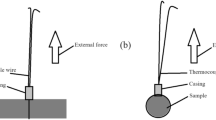Conclusions
-
1.
The freezing-on of babbitt onto a plane surface is an effective fective means for the production and repair of plane bearings.
-
2.
The thickness of the freezed-on babbitt layer is directly proportional to the degree of the supercooling and the hold time of the bearing in the liquid melt.
-
3.
The freezed-on babbitt layer does not contain pores, pits, or nonmetallic inclusions.
-
4.
A strong diffusion coupling is formed between the babbitt layer and the specimen.
Similar content being viewed by others
Author information
Authors and Affiliations
Additional information
Translated from Metallovedenie i Termicheskaya Obrabotka Metallov, No. 7, pp. 36–37, July, 1998.
Rights and permissions
About this article
Cite this article
Gromyko, A.G. Formation of shape and structure in freezing-on A babbitt layer. Met Sci Heat Treat 40, 299–300 (1998). https://doi.org/10.1007/BF02474897
Issue Date:
DOI: https://doi.org/10.1007/BF02474897




